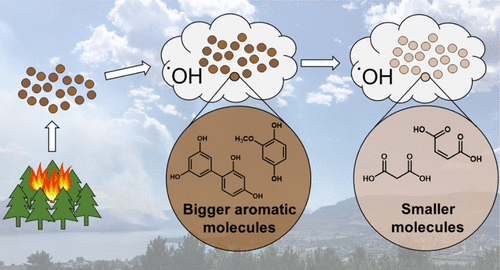当前位置:
X-MOL 学术
›
ACS Earth Space Chem.
›
论文详情
Our official English website, www.x-mol.net, welcomes your feedback! (Note: you will need to create a separate account there.)
Aqueous Photoreactions of Wood Smoke Brown Carbon
ACS Earth and Space Chemistry ( IF 3.4 ) Pub Date : 2020-06-03 , DOI: 10.1021/acsearthspacechem.0c00117 Rachel F. Hems 1 , Elijah G. Schnitzler 1 , Monica Bastawrous 2 , Ronald Soong 2 , André J. Simpson 2 , Jonathan P. D. Abbatt 1
ACS Earth and Space Chemistry ( IF 3.4 ) Pub Date : 2020-06-03 , DOI: 10.1021/acsearthspacechem.0c00117 Rachel F. Hems 1 , Elijah G. Schnitzler 1 , Monica Bastawrous 2 , Ronald Soong 2 , André J. Simpson 2 , Jonathan P. D. Abbatt 1
Affiliation

|
A dominant source of light-absorbing aerosol particles, brown carbon (BrC), to the atmosphere is smoke from biomass burning. Aqueous aging of biomass burning organic aerosol can increase BrC absorbance, which may extend its atmospheric lifetime in aerosol particles, cloud droplets, and fog droplets. This study investigates the aqueous aging of biomass burning BrC and the connection between absorbance and chemical composition. The water-soluble component of laboratory-generated wood smoke BrC was analyzed using aerosol-chemical ionization mass spectrometry, liquid chromatography–mass spectrometry (electrospray ionization), UV–vis spectroscopy, and NMR spectroscopy as it was exposed to UV-B light and OH oxidation to simulate photo-oxidation in the atmosphere. During UV-B light exposure, absorbance at 400 nm increased by greater than a factor of 2 and remained high for the 6 h exposure period. A similar increase in absorbance was observed during OH oxidation, up to an OH exposure of 4 × 10–10 M·s. At a cloud water OH concentration of 1 × 10–14 M, this OH exposure corresponds to ∼11 h of aqueous OH oxidation. Further OH oxidation led to a net loss of absorbance after an OH exposure of 1.5 × 10–9 M·s (∼42 h of aqueous OH oxidation). The increase in absorbance in both cases was linked to the formation of aromatic dimer compounds and functionalized products only during OH oxidation. The loss of absorbance with extended OH oxidation correlated with a loss of aromatic compounds and breakdown to smaller molecules. These results show that aqueous aging of the biomass burning material through photo-oxidation primarily increases the absorbance of BrC and may result in longer-lived BrC in the atmosphere.
中文翻译:

木材烟棕碳的水光反应
来自生物质燃烧的烟雾是向大气中吸收光的气溶胶颗粒(褐碳(BrC))的主要来源。燃烧有机气溶胶的生物质的水老化可提高BrC吸收度,从而延长其在气溶胶颗粒,云滴和雾滴中的大气寿命。这项研究调查了燃烧生物质BrC的水老化以及吸光度与化学成分之间的关系。实验室产生的木烟BrC的水溶性成分使用气溶胶-化学电离质谱,液相色谱-质谱(电喷雾电离),UV-vis光谱和NMR光谱进行了分析,因为它们暴露于UV-B光和OH氧化模拟大气中的光氧化。在UV-B曝光期间,在400 nm处的吸光度增加了2倍以上,并且在6 h的暴露时间内保持较高的吸光度。在OH氧化过程中观察到相似的吸光度增加,直至OH暴露为4×10–10 M·s。在浊水OH浓度为1×10 –14 M时,该OH暴露量相当于OH水溶液氧化约11小时。进一步的OH氧化导致在OH暴露1.5×10 –9 M·s(水溶液OH氧化约42小时)后出现吸光度的净损失。在这两种情况下,吸光度的增加仅在OH氧化期间与形成芳族二聚体化合物和功能化产物有关。随着OH氧化的延长,吸光度的损失与芳族化合物的损失和较小分子的分解有关。这些结果表明,通过光氧化使生物质燃烧材料的水老化主要增加了BrC的吸收,并可能导致大气中BrC的寿命更长。
更新日期:2020-07-16
中文翻译:

木材烟棕碳的水光反应
来自生物质燃烧的烟雾是向大气中吸收光的气溶胶颗粒(褐碳(BrC))的主要来源。燃烧有机气溶胶的生物质的水老化可提高BrC吸收度,从而延长其在气溶胶颗粒,云滴和雾滴中的大气寿命。这项研究调查了燃烧生物质BrC的水老化以及吸光度与化学成分之间的关系。实验室产生的木烟BrC的水溶性成分使用气溶胶-化学电离质谱,液相色谱-质谱(电喷雾电离),UV-vis光谱和NMR光谱进行了分析,因为它们暴露于UV-B光和OH氧化模拟大气中的光氧化。在UV-B曝光期间,在400 nm处的吸光度增加了2倍以上,并且在6 h的暴露时间内保持较高的吸光度。在OH氧化过程中观察到相似的吸光度增加,直至OH暴露为4×10–10 M·s。在浊水OH浓度为1×10 –14 M时,该OH暴露量相当于OH水溶液氧化约11小时。进一步的OH氧化导致在OH暴露1.5×10 –9 M·s(水溶液OH氧化约42小时)后出现吸光度的净损失。在这两种情况下,吸光度的增加仅在OH氧化期间与形成芳族二聚体化合物和功能化产物有关。随着OH氧化的延长,吸光度的损失与芳族化合物的损失和较小分子的分解有关。这些结果表明,通过光氧化使生物质燃烧材料的水老化主要增加了BrC的吸收,并可能导致大气中BrC的寿命更长。



























 京公网安备 11010802027423号
京公网安备 11010802027423号